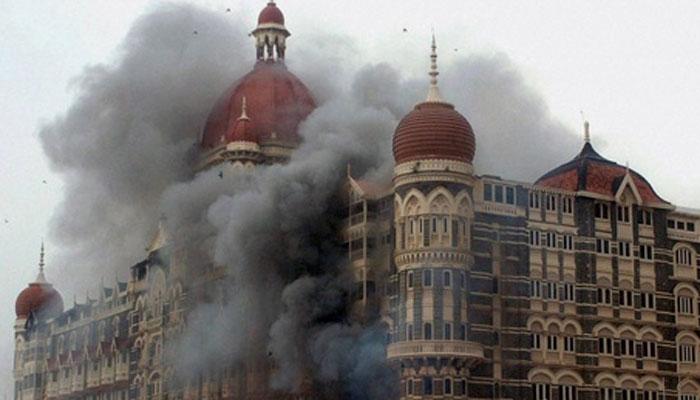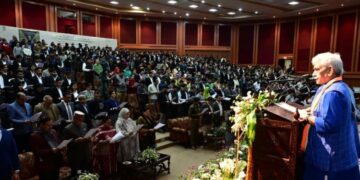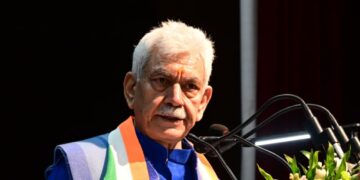New Delhi: A document detailing major terror attacks orchestrated from across the border between 1947 and 2025 was released on Wednesday by NatStrat, a think tank, to coincide with the 17th anniversary of the Mumbai terror attacks.
“The history of Pakistan-sponsored terrorism against India needs to be told and retold,” the report compiled by NatStrat, a not-for-profit centre for research on strategic and security issues, said.
Records stretching back to 1947 suggest a consistent strategy by Pakistan’s military and intelligence apparatus, the Inter Services Intelligence (ISI), of “using terrorism as a state policy against India”.
According to the report titled ‘Chronology of Pakistani Terror Attack on India 1947-2025’, terror activities from Pakistan can be divided into five parts — 1947-71 as an era of foundational conflicts; 1972-89 as rise of proxy warfare; 1990-2000 as escalation and urban attacks; 2001-09 as targeting national symbols; and 2010-25 as adaptive terrorism and hardened response.
Former diplomat Pankaj Saran, with an experience of four decades, is presently the convenor of Delhi-based NatStrat.
Saran has served in key positions in the Prime Minister’s Office, the National Security Council Secretariat, Ministry of External Affairs and in several Indian Missions abroad, including as India’s Ambassador to Russia and India’s High Commissioner to Bangladesh.
He also served as the deputy national security advisor.
The report chronicles the significant “acts of aggression and terror-related activities originating from Pakistan or territory under its control”, illustrating a decades-long policy of “hybrid warfare” against India.
It also highlights India’s remarkable resilience in withstanding such assaults.
“They have not stopped India’s march as a nation. Instead, Indian society and polity have pushed back attempts to divide the country or slow down its progress,” the report said.
The report termed terrorism an affront to humanity, and said state-sponsored terrorism and its use as an instrument of state policy is dangerous and a source of grave instability and also contrary to the principles of international law and inter-state relations.
“It is a scourge that affects the whole world and must be fought unitedly, without reservation or double standards,” the report said, dedicating the compilation as a homage to all the victims of terrorism and a tribute to all those who fought against it.
Here are the five parts of the report — ‘Chronology of Pakistani Terror Attack on India 1947-2025’ – as documented by the NatStrat:
Phase I: The Foundational Conflicts (1947–1971)
1947–1948: Poonch rebellion and the tribal invasion was orchestrated by Pakistan in Jammu and Kashmir to force its accession to Pakistan, prompting the first India-Pakistan war.
Since 1960s: Support to insurgents in Northeast India; the ISI began using asymmetric warfare, establishing training camps in East Pakistan (now Bangladesh) to arm and fund Naga and Mizo insurgents to destabilise India.
1965: Operation Gibraltar was a covert infiltration by Pakistani soldiers disguised as locals into Jammu and Kashmir to incite an armed uprising, which failed and triggered the 1965 India-Pakistan war.
1971: Operation Chengiz Khan was a pre-emptive air strike initiated by Pakistan on December 3, 1971, marking the formal start of the India-Pakistan war of 1971.
India’s response: A meticulously-planned and swiftly-executed military campaign involving coordinated operations by the Indian Army, Navy, and Air Force on both eastern and western fronts quickly overwhelmed the Pakistani forces and culminated in the surrender of approximately 93,000 Pakistani troops in Dhaka on December 16, 1971.
This also led to the creation of an independent Bangladesh, fundamentally altering the geopolitical landscape of South Asia.
Phase II: The rise of proxy warfare (1972–1989)
Hijackings and terrorist acts: Pakistan consolidated its unconventional warfare strategy, partly through orchestrating plane hijackings.
January 30, 1971: Hijacking of an Indian Airlines plane (Ganga) from Srinagar to Lahore by two Kashmiri separatists who blew it up on February 2, 1971, after the crew and passengers had been released.
February 3, 1984: Ravindera Mhatre, an Indian diplomat posted at Birmingham, was kidnapped and brutally murdered on February 5, 1984, by activists of the Kashmir Liberation Army (KLA), an affiliate of the Jammu and Kashmir Liberation Front (JKLF).
August 24, 1984: An Indian Airlines flight bound for Srinagar from Delhi via Chandigarh and Jammu was hijacked and diverted to Lahore by seven Sikh separatists, part of the outlawed All-India Sikh Students Federation.
ISI support to Khalistan movement: The ISI began a sustained proxy war by supporting the Khalistan movement in Punjab to weaken and distract the Indian government.
India’s response to hijackings: India’s response to aircraft hijackings varied. New Delhi strongly criticised Pakistan’s handling of the crises in some cases, while in others, it sought Islamabad’s cooperation to safeguard passengers.
Phase III: Escalation and urban attacks (1990–2000)
Jammu and Kashmir – The K2 Project: The ISI escalated militancy in Jammu and Kashmir, fuelling separatist groups. The Pakistan-based Lashkar-e-Taiba (LeT) made its first incursions into Jammu and Kashmir in 1993.
1993 Mumbai blasts: A series of bomb explosions that killed 257 people was executed in close contact with Pakistan’s ISI, as alleged by investigators.
1996 Lajpat Nagar blasts in New Delhi: A bomb blast in the market killed 13 civilians and was later used by India to highlight Pakistan’s role in state-sponsored terrorism.
1998 Coimbatore bombings: While perpetrated by a local Islamist group, reports suggested these groups were influenced by Pakistan’s ISI to disrupt commerce and target former deputy prime minister and senior BJP leader L K Advani.
1999 Kargil War: Pakistani troops disguised as Kashmiri terrorists infiltrated the Kargil sector, leading to a high-altitude conventional conflict.
1999 IC814 hijack: The hijacking of an Indian Airlines flight that ended with the release of three terrorists, including Jaish-e-Mohammad (JeM) founder Masood Azhar.
2000 Red Fort attack: The Pakistan-based LeT was identified as the perpetrator of the attack.
Phase IV: Targeting of National symbols (2001–2009)
2001 Parliament attack: The five terrorists who attacked the Parliament were identified as Pakistani nationals belonging to the banned Jaish-e-Mohammed terror group. The operation was carried out under the guidance of the ISI.
2002 Akshardham temple attack, Gujarat: Several accused in the bombing were believed to have fled to Pakistan.
2005 Delhi bombings: Terrorists detonated three bombs in crowded markets days before Diwali, killing 67 people.
2006 Mumbai train bombings: The Mumbai Police’s Anti-Terror Squad alleged that LeT was the mastermind and provided arms and training, with the police chief alleging ISI involvement.
2008 attack on Indian Embassy in Kabul: A suicide bomber attacked the Indian Embassy.
2008 Mumbai terror attacks (26/11): Ten LeT terrorists launched coordinated attacks across Mumbai, killing 166 people, bringing bilateral relations to a near standstill.
Phase V: Adaptive terrorism and hardened response (2010–2025)
2010 German Bakery attack in Pune: Linked to the LeT and the Indian Mujahideen (IM) under the ‘Karachi Project’, the motive was to derail peace talks and target Western tourists.
2016 Pathankot attack: Pakistan-based terror group attacked the Pathankot Air Force Station.
2016 Uri attack: A military base was attacked, leading to the Army carrying out ‘surgical strikes’ across the Line of Control (LoC).
2019 Pulwama attack: A suicide bombing claimed by the Pakistan-based JeM killed 40 CRPF personnel. India retaliated with the Balakot airstrikes.
2025 Pahalgam attack: The Resistance Front (TRF), an offshoot of the LeT, claimed responsibility for the targeted killing of 26 innocent tourists, believed to be conducted by operatives trained in Pakistan.
2025 Operation Sindoor: India’s punitive, doctrine-shifting response to the Pahalgam attack, involving targeted military action against terror infrastructure inside Pakistan, which Defence Minister Rajnath Singh explained as treating “any attack on Indian soil as an act of war”.







